Motion NCERT in-text questions class 9
Hello, readers ! This webpage contains class 9th science chapter 8 NCERT in-text questions and solutions. Motion NCERT in-text questions class 9.
NCERT in text questions page 101
An object has moved through a distance. Can it have zero displacement? If yes, support your answer with an example.
Answer: Yes, An object has moved through a distance. It may have zero displacement under following circumstances, (i) An object moving on a circular path has zero displacement for complete cycle as there is no change in position. (ii) If an object moves from a reference point and returns to the same point after travelling some distance, then also its displacement will be zero.
A farmer moves along the boundary of a square field of side 10 m in 40 s. What will be the magnitude of displacement of the farmer at the end of 2 minutes 20 seconds from his initial position?
Answer: Speed of farmer = distance travelled / time taken = 10m / 40s = 0.25m/s
Distance travelled by former in 2 minutes 20 seconds ( = 2*60 + 20 seconds = 140 second ) = speed of farmer * time taken = 0.25 * 140 = 35m
So, Displacement of the farmer at the end of 2 minutes 20 seconds from his initial position A to final position E is equal to 5m.
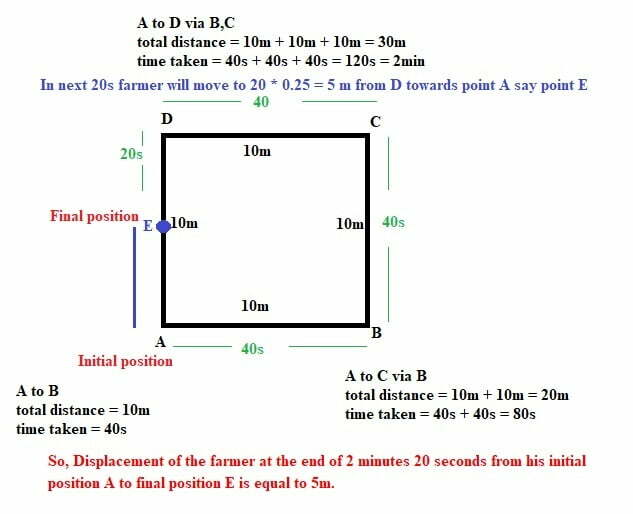
Table of Contents
Which of the following is true for displacement ?
(a) It cannot be zero.
Ans: Not true. Displacement can be equal to zero, if there is no change in position of body.
(b) Its magnitude is greater than the distance travelled by the object.
Ans: Not true. Displacement is always equal to or less then distance but never will be more then distance.
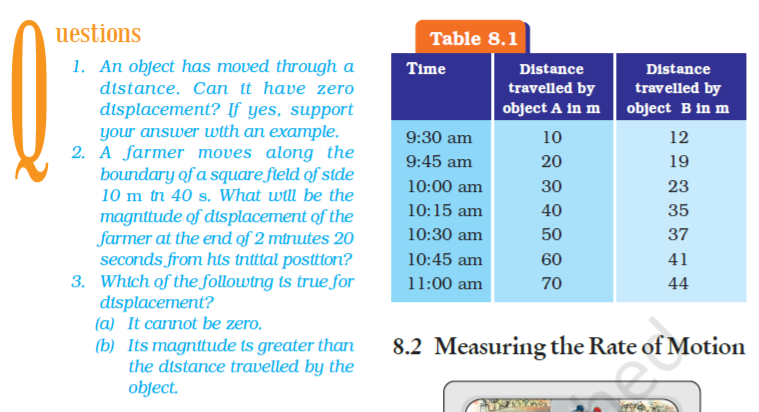
Click here 🖱️👉 Motion – Class Notes Chapter-08
NCERT in-text questions page 102
Distinguish between speed and velocity.
Answer: Difference between speed and velocity
| Speed | Velocity |
| Speed is the total distance travelled by body divided by time taken. | Velocity is the total displacement travelled by body divided by time taken. |
| Speed = distance / time | Velocity = displacement / time |
| Speed is a scalar quantity. | Speed is a scalar quantity. |
| Its SI unit is m/s. | Its SI unit is also m/s. |
| Speed is always positive. | Speed is may be positive, negative or zero. |
Under what condition(s) is the magnitude of average velocity of an object equal to its average speed?
Ans: Average speed = Distance (d ) / time (t) , Average velocity = Displacement ( X ) / time ( T )
Average velocity of an object equal to its average speed under following conditions,
- Distance travelled by object is equal to displacement of object in same interval of time.
- If ratio of d / t is equal to X / T.
What does the odometer of an automobile measure?
Ans: Odometer of an automobile measures, total distance travelled by a vehicle/object.
What does the path of an object look like when it is in uniform motion?
Ans: Path of an object is either straight line or curve, when it is in uniform motion, but its speed must be constant.
During an experiment, a signal from a spaceship reached the ground station in five minutes. What was the distance of the spaceship from the ground station? The signal travels at the speed of light, that is, 3 × 108m s–1.
Sol: Given: Time taken by signal to reach ground station from spaceship t = 5 min = 5*60 = 300s
Speed of signal v = 3 × 108 m s–1
Distance of the spaceship from the ground station d = ?
☞ In above question speed of signal does not changes (constant), so it is the case of uniform motion.
☞ Speed v = d / t d = v × t = 3 × 108 × 300 = 9 × 106 meter
Click here 🖱️👉 Motion – Additional Practice Questions
NCERT in-text questions page 103
When will you say a body is in (i) uniform acceleration? (ii) non-uniform acceleration?
Ans: Uniform acceleration:- If change in velocity per unit time of a body is constant (not zero), body is said to be in uniform acceleration.
Non-uniform acceleration:- If change in velocity per unit time of a body is not constant (variable), body is said to be in non-uniform acceleration.
Extra facts ☞ If change in velocity per unit time of a body is zero, body is said to be in uniform motion.
A bus decreases its speed from 80 km h–1 to 60 km h–1 in 5 s. Find the acceleration of the bus.
Ans: Given: Initial speed u = 80 km h–1 = 80 × 5/18 = 200 / 9 m s–1
Final speed v = 60 km h–1 = 60 × 5/18 = 150 / 9 m s–1
Time taken t = 5s
Acceleration = ?
☞ In above question speed of body changes, so it is the case of accelerated motion.
From equation of motion 1st v = u + at
a = (v-u) / t = (150/9 – 200/9 ) / 5 = – 50 / 45 = – 1.11 m s–2
Here, negative sign of acceleration indicates that speed of body is decreasing i.e. retardation.
A train starting from a railway station and moving with uniform acceleration attains a speed 40 km h–1 in 10 minutes. Find its acceleration.
Ans: Given: Initial speed u = 0
Final speed v = 40 km h–1 = 40 × 5/18 = 100 / 9 m s–1
Time taken t = 10min = 10 × 60 = 600s
Acceleration = ?
☞ In above question speed of body changes, so it is the case of accelerated motion.
From equation of motion 1st v = u + at
a = (v-u) / t = (100/9 – 0 ) / 600 = 100 / 5400 = 0.0185 m s–2
Here, positive sign of acceleration indicates that speed of body is increasing.
NCERT in-text questions page 107
Click here 🖱️👉 Motion NCERT Solutions
What is the nature of the distance-time graphs for uniform and non-uniform motion of an object?
Ans: Distance-time graphs for uniform motion is straight line.
Distance-time graphs for non-uniform motion is curve or parabolic in nature.
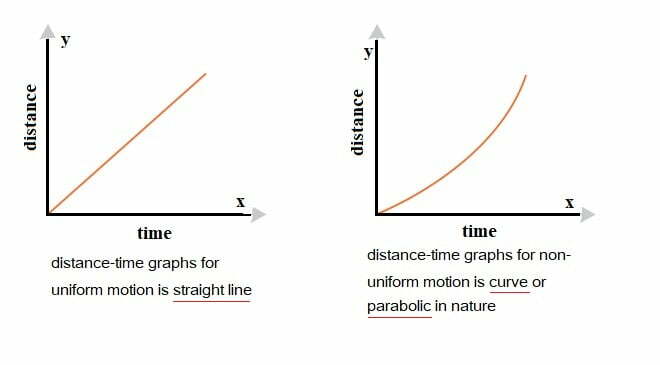
What can you say about the motion of an object whose distance-time graph is a straight line parallel to the time axis?
Ans: If distance-time graph is a straight line parallel to the time axis then body is in stationary condition as position of object does not change with respect to time.
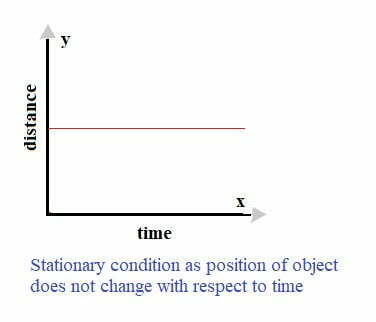
What is the quantity which is measured by the area occupied below the velocity-time graph?
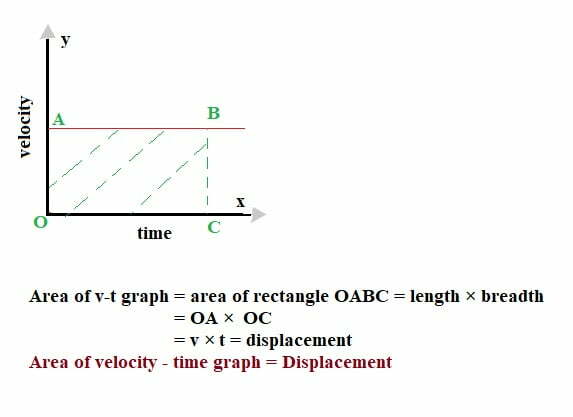
NCERT in-text questions page 107
A bus starting from rest moves with a uniform acceleration of 0.1 m s-2 for 2 minutes. Find (a) the speed acquired, (b) the distance travelled.
Ans: Given: Initial speed u = 0 ( bus starting from rest )
Acceleration = 0.1 m s–2
Time taken t = 2min = 2 × 60 = 120s
Speed acquired (Final speed) v = ?
distance travelled x = ?
☞ In above question speed of bus (rest to motion) changes, so it is the case of accelerated motion and can be solved using three equations of motion.
From equation of motion 1st v = u + at
v = 0 + 0.1 × 120 = 12 m s–1
From equation of motion 2nd x = u t +1/2 at2
x = 0 × 120 +1/2 0.1 × (120)2 = 720 m
A train is travelling at a speed of 90 km h–1. Brakes are applied so as to produce a uniform acceleration of – 0.5 m s-2. Find how far the train will go before it is brought to rest.
Ans: Given: Initial speed u = 90 km h–1 = 90×5/18 m s–1 = 25m s–1
Acceleration (retardation) = – 0.5 m s–2
Speed acquired (Final speed) v = 0 (finally train comes to rest)
distance travelled x = ?
☞ In above question speed of train changes (from motion to rest), so it is the case of accelerated motion and can be solved using three equations of motion.
From equation of motion 3rd v2 – u2 = 2 ax
X = (v2 – u2 ) / 2 a = = (02 – 252 ) / 2 (-0.5) = 625 m
A trolley, while going down an inclined plane, has an acceleration of 2 cm s-2. What will be its velocity 3 s after the start?
Ans: Given: Initial speed u = 0 (starting from rest)
Time taken t = 3s
Acceleration (retardation) = 2 cm s–2
Final speed v = ?
☞ In above question speed of trolley changes (from rest to motion), so it is the case of accelerated motion and can be solved using three equations of motion.
From equation of motion 1st v = u + at
v = 0 + 2 × 3 = 6 cm s–1
A racing car has a uniform acceleration of 4 m s-2. What distance will it cover in 10 s after start ?
Answer: Given: Initial speed u = 0 (starting from rest)
Time taken t = 10s
Acceleration (retardation) = 4 m s–2
distance covered x = ?
☞ In above question speed of trolley changes (from rest to motion), so it is the case of accelerated motion and can be solved using three equations of motion.
From equation of motion 2nd x = u t +1/2 at2
x = 0 × 10 +1/2 4 × (10)2 = 200 m
A stone is thrown in a vertically upward direction with a velocity of 5 m s-1. If the acceleration of the stone during its motion is 10 m s–2 in the downward direction, what will be the height attained by the stone and how much time will it take to reach there?
Ans: ☞ In above question speed of stone change as it move upward/downward, so it is the case of accelerated motion (motion under gravity) and can be solved using three equations of motion. Here physical quantities involved in equations of motion displacement, velocity, acceleration are vectors. If direction of these vectors are different/opposite in motion then we have to take sign convention. Physical quantities having direction upward are taken as positive, downward as negative and vice-versa.
Given: Initial velocity = + 5 m s-1 (stone is thrown in a vertically upward direction)
Final velocity = 0 (at highest point velocity becomes zero)
Acceleration (Acceleration due to gravity always downward) = – 10 m s–2
Time taken t = ?
height attained (distance covered) h = x = ?
From equation of motion 3rd v2 – u2 = 2 ax
h = (v2 – u2 ) / 2 a = = (02 – 52 ) / 2 (-10) = 1.25 m
From equation of motion 1st v = u + at
0 = 5 + (-10) × t
Time taken t = 0.5 s
MY YouTube Channel Link : 👉🖱 https://www.youtube.com/channel/UCGpC7nWE0-bBv9I53MM8qjQ
Motion NCERT in-text questions class 9 , Motion NCERT in-text questions class 9 , Motion NCERT in-text questions class 9 , Motion NCERT in-text questions class 9 , Motion NCERT in-text questions class 9 , Motion NCERT in-text questions class 9 , Motion NCERT in-text questions class 9 , Motion NCERT in-text questions class 9 , Motion NCERT in-text questions class 9 , Motion NCERT in-text questions class 9 , Motion NCERT in-text questions class 9 , Motion NCERT in-text questions class 9 , Motion NCERT in-text questions class 9 , Motion NCERT in-text questions class 9 , Motion NCERT in-text questions class 9 ,
Motion NCERT in-text questions class 9 , Motion NCERT in-text questions class 9 , Motion NCERT in-text questions class 9 , Motion NCERT in-text questions class 9 , Motion NCERT in-text questions class 9 , Motion NCERT in-text questions class 9 , Motion NCERT in-text questions class 9 , Motion NCERT in-text questions class 9 , Motion NCERT in-text questions class 9 , Motion NCERT in-text questions class 9 ,